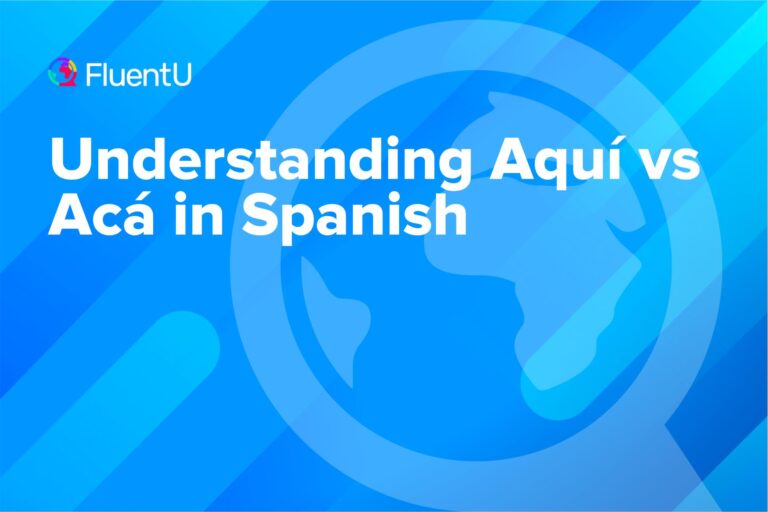Contents
- Advanced Spanish Verbs You Should Know
- 1. Acostumbrarse — To be used (to)/accustomed (to)
- 2. Agarrar — To grab/grasp/hold on to
- 3. Bostezar — To yawn
- 4. Contradecir — To contradict
- 5. Chiflar — To whistle / be excited about / be crazy about
- 6. Desmayarse — To faint
- 7. Estornudar — To sneeze
- 8. Ladrar — To bark
- 9. Porfiar — To insist/persevere
- 10. Quejarse — To complain/groan/moan
- Why Learn Advanced Spanish Verbs?
- And One More Thing…
10 Advanced Spanish Verbs

Instead of using the same old verbs like tener, salir, querer and those other trusty friends you learned back in beginners’ class, at some point, you have to broaden your verb vocabulary.
That’s why we came up with this handy list of ten advanced Spanish verbs ready to be used by you.
Read them, familiarize yourself with them and then start using them!
Download: This blog post is available as a convenient and portable PDF that you can take anywhere. Click here to get a copy. (Download)
Advanced Spanish Verbs You Should Know
1. Acostumbrarse — To be used (to)/accustomed (to)
This is one you might not have learned earlier on, and means “to be/get used to” something.
It’s a reflexive regular verb, so it needs a reflexive pronoun before the conjugated verb, or, when in the infinitive, after the verb:
Me acostumbré a la vida en España. (I got used to my life in Spain.)
Tengo que acostumbrarme a mi nuevo trabajo. (I need to get used to my new job).
Notice that we use this reflexive verb with the preposition “a,” making it one of many Spanish phrasal verbs.
2. Agarrar — To grab/grasp/hold on to
Agarrar is a regular verb with a tricky pronunciation because of the rr sound, but it sounds great if you can manage it.
Idioms with agarrar include agarrar a golpes (to fight or beat someone), agarrar el dinero (to steal the money) and agarrar a besos (to kiss intensely).
For example:
Agarra bien tu bolsa porque hay ladrones por acá. (Hold on tightly to your bag because there are thieves around here.)
Tengo que agarrar mis llaves y vamos. (I need to grab my keys and let’s go.)
Note that in some Latin American countries, the verb’s reflexive form agarrarse has a sexual connotation and can mean that a couple kissed or even had sex:
Nos agarramos ayer. (We kissed/had sex yesterday.)
3. Bostezar — To yawn
This verb means “to yawn.”
It might not be a particularly advanced word in itself, but it’s the kind of verb that often gets missed out of Spanish textbooks or classes.
Here’s an example:
Yo bostezo cada vez que escucho música relajante. (I yawn every time I listen to relaxing music.)
4. Contradecir — To contradict
Contradecir, which means “to contradict,” is actually two words shoved together. Contra means “against or opposite” and decir means “to say.” The combination of the two logically means “to contradict.”
Contradecir is usually followed by the preposition a.
The verb is irregular and follows the same patterns as decir, so in the preterite tense, it conjugates to form sentences like:
Lucía contradijo a su hermano. (Lucía contradicted her brother.)
This verb can also be a reflexive verb—to contradict oneself—contradecirse. An example of this is:
Me contradigo todo el tiempo. (I am always contradicting myself.)
5. Chiflar — To whistle / be excited about / be crazy about
Chiflar means to whistle, but it’s actually more often used to mean being excited or crazy about something. Chiflar can also mean to boo or hiss at someone.
Here’s a couple examples:
Me chifla el chocolate. (I’m crazy about chocolate.)
Caminando por el bosque, chiflo para imitar el canto de los pájaros. (While walking through the forest, I whistle to imitate the song of the birds.)
6. Desmayarse — To faint
This one means “to faint.” Perhaps useful on a hot day when you’re not properly hydrated (which too often happens to travelers in Latin America).
It’s another reflexive verb and is regular.
Here’s an example:
¡Me desmayé! (I fainted!)
7. Estornudar — To sneeze
While we’re on bodily functions, another useful verb is estornudar, which means to sneeze.
Related vocabulary is: pañuelo (tissue or handkerchief.)
This word also has a nice idiom associated with it: el mundo es un pañuelo (the world is a handkerchief), which is similar to the phrase “it’s a small world.”
Here’s an example sentence using this verb:
Necesito estornudar pero no puedo. (I need to sneeze but I can’t.)
8. Ladrar — To bark
Did you know that animals in Spanish make different noises than they do in English?
That’s right. Spanish dogs don’t woof, they guau guau. Cats ronronean when they purr and roosters go quiquiriquí.
But the actual verb for “barking” is ladrar (and yes, a person can bark, too).
For example:
¡El perro está ladrando muy fuerte! (The dog is barking really loudly.)
9. Porfiar — To insist/persevere
Porfiar actually means to insist or persevere with something.
It’s an irregular verb, since in the first person there’s an accent on the i in some forms, it goes: porfío, porfías, porfía, porfiamos, porfiáis, porfían.
Here’s an example sentence:
Porfió y al final solucionó el problema. (He persisted and eventually solved the problem.)
10. Quejarse — To complain/groan/moan
Another reflexive verb, quejarse means to complain, groan or moan.
It’s a particularly useful one when traveling, since grumpy, jet-lagged people have the tendency to complain about missed flights, bad service and lost luggage.
Here’s an example:
Me quejé porque no me gustó la comida. (I complained because I didn’t like the food.)
You can also use quejarse de to complain about something:
Mi tía siempre se queja de todo. (My aunt is always complaining about everything.)
Why Learn Advanced Spanish Verbs?
A verb is like the backbone of a sentence. Not only does it convey a lot of the meaning, it also tells us what time period we’re talking about.
At an intermediate or advanced Spanish level, it’s a good idea to swap your basic verbs for those of a more sophisticated caliber. Just like one progresses to finer wines with age, or moves on from speaking like a two-year-old.
While we’re not suggesting you cut out basic verbs like ser, estar, tener and haber, it’s good to have a few other options up your sleeve for when you want to impress—or simply speak normally, naturally and fluently. One great option for hearing advanced Spanish verbs in context is FluentU.
FluentU takes authentic videos—like music videos, movie trailers, news and inspiring talks—and turns them into personalized language learning lessons.
You can try FluentU for free for 2 weeks. Check out the website or download the iOS app or Android app.
P.S. Click here to take advantage of our current sale! (Expires at the end of this month)

You can also learn new verbs by reading Spanish novels for advanced learners and noting down any unfamiliar words you come across, trying to guess their meaning from the context and then looking them up later.
So there you have it, 10 new advanced Spanish verbs to add some depth to your language studies. What’s next? We challenge you to use them all this week, or even to write a short story involving them all.
Good luck, remember you need to porfiar and we hope that you’re able to acostumbrarse to using them soon.
Download: This blog post is available as a convenient and portable PDF that you can take anywhere. Click here to get a copy. (Download)
And One More Thing…
If you've made it this far that means you probably enjoy learning Spanish with engaging material and will then love FluentU.
Other sites use scripted content. FluentU uses a natural approach that helps you ease into the Spanish language and culture over time. You’ll learn Spanish as it’s actually spoken by real people.
FluentU has a wide variety of videos, as you can see here:

FluentU brings native videos within reach with interactive transcripts. You can tap on any word to look it up instantly. Every definition has examples that have been written to help you understand how the word is used. If you see an interesting word you don’t know, you can add it to a vocab list.

Review a complete interactive transcript under the Dialogue tab, and find words and phrases listed under Vocab.

Learn all the vocabulary in any video with FluentU’s robust learning engine. Swipe left or right to see more examples of the word you’re on.

The best part is that FluentU keeps track of the vocabulary that you’re learning, and gives you extra practice with difficult words. It'll even remind you when it’s time to review what you’ve learned. Every learner has a truly personalized experience, even if they’re learning with the same video.
Start using the FluentU website on your computer or tablet or, better yet, download the FluentU app from the iTunes or Google Play store. Click here to take advantage of our current sale! (Expires at the end of this month.)














